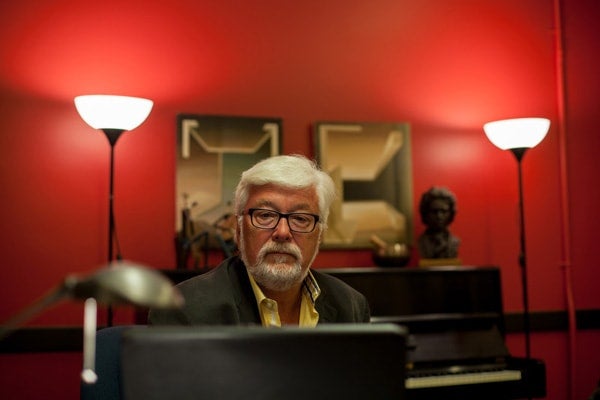
Beat It! Listening to music leads to longer workouts, U of T researchers say
Published: June 19, 2015
Listening to music while you exercise can increase the length of your workout by up to 70 per cent, shows new research from the University of Toronto. The study found that cardiac patients who listened to music that was synchronized with the tempo of their workout had greater compliance to exercise plans and increased their overall daily activity.
“People walking to music with a beat at the speed of their steps have better fitness results than people who do not use music,” says Professor Lee Bartel, founder and acting director of U of T’s Music and Health Research Collaboratory. “And when people listen to music with an amplified beat – sort of like walking to marching music where the walking beat is very strong – these people have even better fitness results than those just walking with regular music. The effect seems to be that they are more active throughout the rest of their day too, not just while doing their workout.”
The study, recently published in the journal Sports Medicine – Open, was conducted at the Toronto Rehab hospital and involved 34 cardiac rehabilitation patients.
One third of patients did not listen to music during their prescribed cardiac rehabilitation exercises and the other two-thirds listened to music that was selected because its tempo matched the patients’ prescribed walking or running pace – which researchers refer to as tempo-pace synchronized music.
“The music tempo-pace synchronization helps cue the person to take their next step or stride and helps regulate, maintain and reinforce their prescribed exercise pace,” said Dr. David Alter, a Senior Scientist at the University Health Network and professor in U of T’s Faculty of Medicine.
Half of the patients who listened to music heard songs that had been acoustically modified using a technique that amplified the beat. Songs were digitally altered by inserting extra rhythmic beats – called rhythmic auditory stimulation – to further enhance tempo-pace synchronization. The group was not aware their music had been modified.
Patients who listened to tempo-pace synchronized music exercised an average of 105.4 minutes per week longer than patients who did not listen to music. Furthermore, the group whose music had been sonically enhanced with extra rhythmic beats achieved the greatest increase in their total weekly activity, averaging an additional 261.1 minutes or more of weekly psychical activity than their music or non-music listening counterparts – corresponding to a 70 per cent increase in weekly exercise.
“We hope these findings will lead people to select workout music that is at the right pace for their activity instead of just listening to ‘high energy music,’” says Bartel. “We also hope to see a better understanding of the connection between the beat we hear and how our muscles respond. Ultimately, perhaps some product – like an app – might help people find the right music and enhance the beat to make it a more effective workout playlist.”
Researchers are planning future trials to further test the clinical application of tempo-pace synchronized music with and without RAS in cardiac rehab patients.
Bartel is director of U of T’s Music and Health Research Collaboratory (MaHRC), an institute within the Faculty of Music that explores the role sound plays in health. The inter-disciplinary institute was established in 2012 and has recruited 50 researchers from around U of T, its nine partner hospitals, universities around the world and organizations like the Royal Conservatory, the International Association of Music Medicine and the Canadian Hearing Society.
“I had first proposed something like this in 2005 and when Don McLean joined us as the new Dean in 2011, he came from McGill's Centre for Interdisciplinary Research in Music Media and Technology [CIRMMT; pronounced Kermit]. They’re a top-notch, world-class research organization that does a lot of the musical neuroscience in Montreal,” says Bartel. “So when McLean came here he wanted something similar to be established but not quite a replica of McGill’s CIRMMT. When I proposed the idea of MaHRC he was very supportive and appointed me as the first associate dean of research for the faculty which gave me the authority to negotiate and draw in the 20 – 25 labs, institutes and research centres who were willing to affiliate with us and create this Collaboratory.”
MaHRC researchers believe music and sound may play an important role in treating health complications. This year they will be studying the role music and sound can play in the treatment of mental health issues, neurological disorders such as Parkinson’s disease, hearing disorders, fibromyalgia and reducing cognitive impairments in children caused by radiation to treat brain tumours.
“The magic of MaHRC is that it has become a magnet to pull together health and music researchers who normally would not have collaborated,” says Bartel. “There has been good work done, but it has been done in silos. Now, working as a network, we see MaHRC as the root of an explosion of new knowledge that can be applied to many of the most serious health challenges we face.”
Listen to examples of tempo-pace synchronized music* (for best results, use headphones):
- This track is regular tempo-pace synched music.
- This track is tempo-pace synched and has extra rhythmic beats inserted.
*Words & Music to "Need you now the same" by David Alter
Performed by David Alter Music
(c) David Alter 2012
www.davidaltermusic.com
Michael Kennedy is a writer with University of Toronto Communications.



